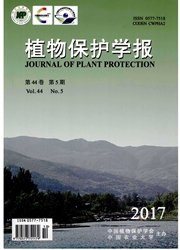

 中文摘要:
中文摘要:
为检测东北地区亚洲玉米螟Ostrinia furnacalis滞育幼虫在越冬期间生理指标的变化情况以及各地理种群间抗寒能力的差异,采用热电偶法于2013年11月—2014年4月对北至黑龙江省黑河市、南到辽宁省瓦房店市的12个地理种群滞育幼虫的过冷却点、冰点、虫体含水量和脂肪含量进行了测定。结果表明,不同地理种群亚洲玉米螟过冷却点在-5~-25℃、冰点在-2.5~-15℃范围内,随着环境温度的变化,过冷却点呈先下降后上升的趋势,最低点出现在1、2月且随地理纬度的升高而降低。不同种群的虫体含水量在50%~70%之间,时序上呈先下降后上升的趋势,与环境温度、过冷却点变化趋势一致;最高含水量出现在4月,最低含水量随着地理纬度的降低而升高。不同种群的虫体脂肪含量在45%~70%之间,时序上呈先上升后下降的趋势;最高脂肪含量随着地理纬度的降低而降低。幼虫最低过冷却点、最低冰点与虫体最低含水量和最高脂肪含量均显著相关,相关系数分别为0.733、-0.736、0.643和-0.636。表明亚洲玉米螟滞育幼虫的抗寒性存在明显的地理分化,高纬度地区种群抗寒力强于低纬度地区种群,幼虫减少体内含水量、增加脂肪积累是提高其抗寒能力的重要生理变化。
 英文摘要:
英文摘要:
To investigate the cold hardiness dynamics of Asia corn borer Ostrinia furnacalis, the supercooling point,freezing point,and cold hardiness-related compounds of overwintering larvae of twelve geographical populations collected from Heilongjiang, Jilin and Liaoning provinces, located in the northeastern China,were examined monthly from November 2013 to April 2014. The supercooling points of different populations were between- 25℃ and- 5℃,and their freezing points were between- 15℃and- 2. 5℃. As the environmental temperature changed,the supercooling points of O. furnacalis showed a trend of dropping first and then rising up. The minimum supercooling points were observed in January or February,which declined with the increase of the latitude of a population. Water contents of different populations were 50%- 70%,showing a trend of dropping first and then rising up,which were consistent with the trend of environmental temperature and supercooling points. The maximum water contents were observed in April,and the lowest water contents increased from northern to southern populations. Lipid contents basically ranged from 45% to 70%,showing a trend of rising up first and then falling. The highest lipid contents decreased from northern to southern populations. The lowest supercooling points and the lowest freezing points were significantly correlated with the lowest water contents and highest lipid contents of the larvae,with a correlation coefficient of 0. 733,- 0. 736,0. 643and- 0. 636,respectively. There was obvious geographical differentiation in the cold hardiness of O.furnacalis diapause larvae,as the cold hardiness of populations from high latitudes was better than populations from low latitudes. It was an important physiological change that the larvae reduced water content and increased accumulation of lipid in the body for improvement of cold hardiness.
 同期刊论文项目
同期刊论文项目
 同项目期刊论文
同项目期刊论文
 期刊信息
期刊信息
